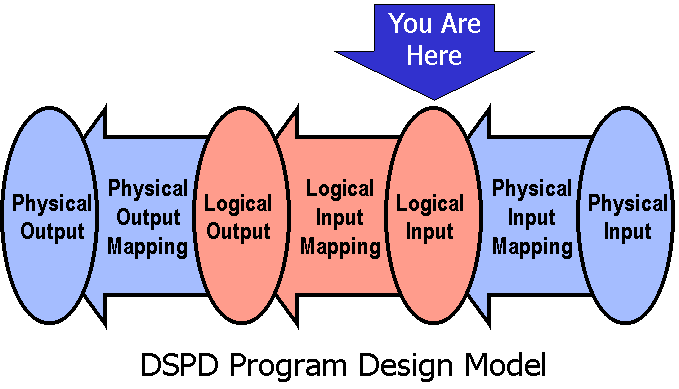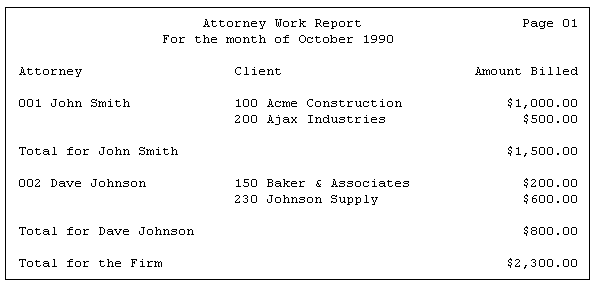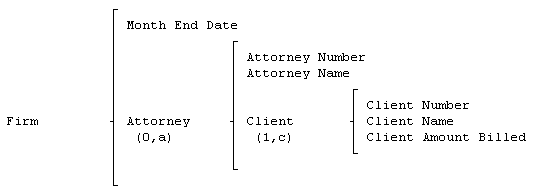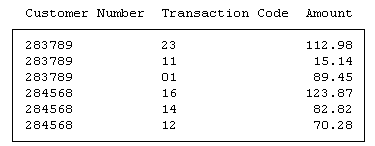
| Dave Higgins Consulting Strategic Technology Consulting and Enterprise Architecture |
Home | What's New | What's Old | Articles | Associates | Interesting Links | Cool Stuff |
Logical Data Structures
Introduction
The creation of the Logical Data Structure (LDS) is the second of seven steps in program design.

Step Two: Create a Warnier/Orr diagram depicting the structure of the minimum necessary logical input. This Logical Data Structure can be built from information gathered on the Output Definition Form: the Input (or Change) Frequencies listed become the hierarchy shown on the LDS; the Data Elements marked as "*" (required) become the data features shown on the LDS.
Example Whereas the Logical Output Structure shows the data which is logically output, the Logical Data Structure shows the minimum data which must be logically input. The LDS is quite often a subset of the LOS: on many outputs the LDS can be created from the LOS by simply removing the Labels and Computed data elements. When this is true for an output, the output is said to be "well-behaved."
Occasionally, the LDS can have features which are not present on the LOS. These "hidden" features will be discussed shortly. LDS's containing hidden features are said to be "ill-behaved."
Consider the output prototype examined earlier...

The Logical Data Structure for this output is as follows...

The LDS says that in order to be able to produce the output, the input must be available by Client within Attorney for the Firm; further that Client Number, Name, and Amount Billed must be available for each Client; Attorney Number and Name must be available at the beginning of each Attorney; and Month End Date must be available at the beginning of the Firm.
Again, notice that the Logical Data Structure DOES NOT reflect the actual input data which is available to the program. It is created independently of knowledge of the real input data in order to preserve information hiding aspects mentioned earlier. If the real input is not the same as the logical input, it will be the job of the Physical Input Mapping section of the program to make the conversion.
The Logical Data Structure always reflects "perfect" data: just the data needed for the output in just the sequence needed, with no extra data and no bad data.
Hidden
Data Elements
Hidden data elements are those which are needed for calculation,
but which do not appear explicitly on the output. As an example,
consider the following output prototype...

It it obvious from inspection of this output that the running Balance is a computed data element: the Check Amounts are being subtracted from the Balance and the Deposit Amounts are being added to the Balance. However, there is clearly a Beginning Balance Amount necessary for the calculation of the first Balance; this is an example of a "hidden" data element. The element "Beginning Balance Amount" DOES NOT appear on the Logical Output Structure (LOS), since that element is not explicitly on the output. It DOES appear on the Logical Data Structure (LDS) since it is required as input.
Again, notice that the data actually available as input IS NOT a consideration when deciding what to show on the LDS; the data present on the LDS is the minimum data required to produce the output.
Hidden
Hierarchies
Hidden Hierarchies are those levels of data visible in the Input
(or Change) Frequencies of the data but not visible in the Output
Frequencies. They are always related to the sorting sequence: the
Logical Data Structure (LDS) will reflect all levels of sorting
even if those levels are not reflected on the Logical Output
Structure. Consider the following file fragment...

Although it is output on each Transaction record, Customer Number is the same for a whole group of Transactions (assuming the output is in Customer Number sequence). Thus, the Logical Output Structure looks something like...

while the Logical Data Structure looks like...

Whenever sorting data appears on an output more often than its contents change, the Logical Data Structure for that output will have "hidden" levels which are not present on the Logical Output Structure.
Note that if you are developing an output for a client, it is generally not a good idea to include "hidden" features. An output is almost always easier to understand and use if it is a "well-behaved" output.
Tips
and Hints
When developing Logical Data Structures, there are several things
to keep in mind...
Home | What's New | What's Old | Articles | Associates | Interesting Links | Cool Stuff |
This web site and all
material contained herein is Copyright ©2002-2009 Dave
Higgins. All Rights Reserved. For additional information,
please contact me at: |